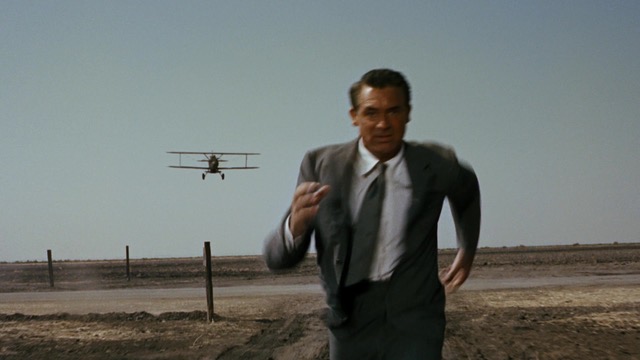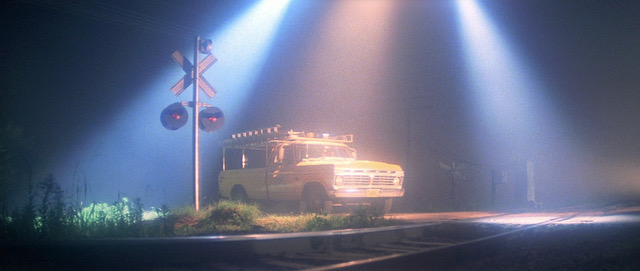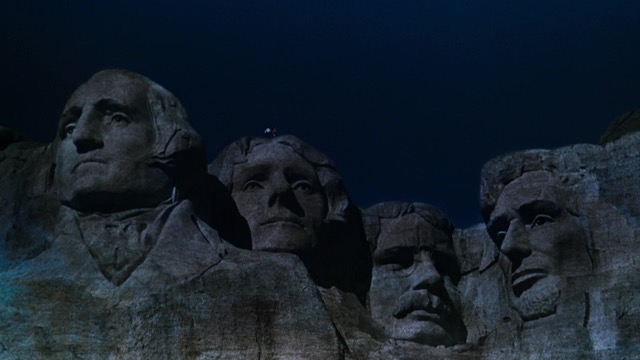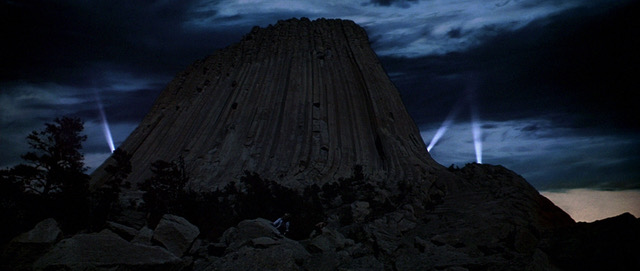COMPANION PIECES with Neil Marshall
- Rich

- May 6, 2024
- 12 min read
Updated: Jun 28, 2024
North by Northwest (1959) / Close Encounters of the Third Kind (1977)

Wearing his influences firmly on his sleeve, writer/director Neil Marshall is one of those British filmmakers who manages to fully deliver the genre goods; his films heavily inspired by the bombastic action and adventure we would associate with our American cousins. But it’s his British sensibility — shining more moonlight on those voices outside of London — that often lends his films a unique accent and flavour. His debut Dog Soldiers is a GOAT werewolf movie, while his second feature The Descent is not only one of the best British horror movies but one the best horror movies. Period.
First and foremost, Neil is an avid appreciator of cinema (and a student of film) who is articulate, observant and, most importantly, adventurous in life... and, therefore, adventurous in his filmmaking. With the floodgates opened after the strikes, it was finally full steam ahead (at the time of this interview) writing one project and editing another. Taking a break from his busy schedule, Neil found some time to share the common links between Alfred Hitchcock’s North by Northwest and a personal favourite: Steven Spielberg’s Close Encounters of the Third Kind while also discussing his thoughts on the hybridisation of genre he also does so well.
What attracted you to this double feature and what is it particularly that made them stand out as Companion Pieces?
It all sprang from something I read a long time ago based on Spielberg having mentioned that there was a lot of North by Northwest in Close Encounters of the Third Kind. At that point, I’d started looking for it and noticing the influences. There is a moment, which is really on the nose when one of the project leaders reports: “We now show uncorrelated targets approaching from the north-northwest.” But then you really do end up looking for all these visual connections such as the backdrops and horizons that match… even listening to the music there are still some sonic connections in John Williams’ score which is reminiscent of Bernard Herrmann’s in places.
Visual echoes. There are many shots throughout that reflect each other.
Other obvious parallels are there with the characters clambering over a giant rock; these edifices in similar locations, runways mapped out into the wilderness… these (seemingly) little connections. The more I analysed all of this, the more I thought, oh, the connections are pretty strong. The visual style in particular is naturally linked via Matthew Yuricich’s having worked on both films with his incredible matt paintings; the road by the sea in North by Northwest very similar to the road from Close Encounters. There is just so much connective tissue.
The shapes Hitchcock employed were so methodical and well-designed. Spielberg is certainly an inheritor of Hitchcock with the suspense and style; each film also having these hugely important turning points situated at a crossroads.
Yeah, Spielberg is certainly a huge student of Hitchcock and even comes across in his first feature, Duel. But it still makes you question how much was subconscious because of how certain films would have been stuck in the back of his mind… and then it all creeps through into certain shots; consciously designed to look like that. So, you know, if something takes place at a crossing in both movies was it deliberate or was it just pure chance? You would have to ask Spielberg [laughs], but I think it was interesting that both the main characters end up at a crossroads and something from the sky comes down to attack them or assail them in some form, be it a UFO or crop duster. It’s in that quote again: “Okay, watch the skies please...”
At the crossroads. A threat from the sky threatens both protagonists.
In looking at filmmakers who understood genre filmmaking, it is also interesting that Hitchcock defined so many genres — spy movies, action, psychological horror — and then Spielberg began to merge genres. In light of that, do you think Spielberg is the forerunner of this hybridisation? Something you also apply.
I think Steven’s part of a generation who, for the first time, kind of acknowledged cinema that came before and paid tribute through homage and in-jokes. There is obviously Spielberg and Lucas, but John Carpenter also openly admits he is massively inspired by Howard Hawks, which shows in the likes of Assault on Precinct 13 and The Thing. I don’t recall directors before then talking about early directors. There’s also another Hitchcock/Spielberg connection via Truffaut who released his interviews in his 1966 book, Hitchcock/Truffaut. Truffaut starred in Close Encounters, so it feels as though Spielberg was maybe cathartically pouring out all this love for Hitchcock in his early movies.
Respect like that just highlights all the more how his generation was the first students of film.
Definitely. Some of them went through the first film schools, whereas a lot of the other directors from the previous generation learnt on the job as a part of the studio system. The Spielberg/Lucas generation — the ‘Movie Brats’ — were the first film students who became filmmakers and they have always worn that on their sleeve. They understand the history of film and know other film directors and references. It’s part and parcel. There’s Duel, as mentioned, but there is certainly plenty of Hitchcock in Jaws and as a Hitchcock-inspired movie Close Encounters is the next step on that road. As Spielberg developed as a filmmaker, the influence was less and less, but those early films heavily relied on the inspiration from not only this ‘Master of Suspense’ but also a master of genre. I’m sure it all lent a sense of confidence for what he was doing during that first decade of filmmaking.
Do you think a lot of it is also to do with latching on to popular culture and leaving the highly politicised element of the seventies behind; a return to the golden age and something more fun and adventurous?
Absolutely.
I do love the central monolithic element you have touched upon with the summit endings with Mount Rushmore vs. Devil’s Tower. It’s just little things like the textures of the mountains, the shapes and the details in there. Again, this brings up whether intentional or by osmosis.
Well, geographically those two places are only a couple of hours from each other across a state border. Mount Rushmore is in South Dakota and Devil’s Tower a national reserve in Wyoming, so, naturally, the landscape is very similar. Taking a major deviation [laughs] I inadvertently went on a pilgrimage to Devil’s Tower when I was driving from Los Angeles to Vancouver.
Monoliths. Mount Rushmore vs. Devil's Tower.
That’s some detour!
What can I say… I just always wanted to go to Devil’s Tower and thought this might be my only chance. It was bizarre. Almost a transcendent experience of this thing approaching on the horizon — a landmark that’s meant so much to me for so long — and you finally see it in person getting bigger and bigger and bigger… and then you’re standing next to it and you recognise all the different angles they shot from. I pondered a little bit and then I was looking for a certain road where they shot the first reveal of the tower in the movie. So I found all those places and I was almost trying to recreate those shots with my phone. I even toyed with the idea of going a little further east to the National Monument… but I bottled it and turned back west to get back to Vancouver.
What an experience. It is literally a location that looks like it was created for a movie until you realise it is a real landmark; very much reflective of that kind of filmmaking where every detail is considered from effects to location, using as much as they could in camera. Beautifully done.
Yuricich’s matt paintings really add to that. You look back on Hitchcock’s use of visual effects with the seamless use of those paintings and locations… it was no wonder it drew audiences in, without them realising the tricks.
Just the tweaks; even the interiors where he would choose very particular angles and through-lines pointing to characters; strong compositions that helped redesign the spaces. Incredible.
Wonderful tricks extending on the roads and architecture. It is set in Indiana but controlled so much in a studio. Therefore, the tricks are unavoidable.
It has to be doctored. Some structures you can maybe get away with more than something as iconic as Devil’s Tower, but there are certain things for movies that you can’t really reuse again because of how potent they are. You could have certain buildings or architecture dressed and shot differently — the Bradbury Building for Blade Runner and 500 Days of Summer — so you can recontextualise all of that as it all takes on a different character under the dressing, framing and lighting.
I don’t know that I’ve ever seen Mount Rushmore in any other movies. Devil’s Tower appeared in Paul, but that was done purely as homage. It’s just too iconic to get away with any other way than a tip of the hat.
“You look back on Hitchcock’s use of
visual effects with the seamless use of those
paintings and locations… it was no wonder it drew
audiences in, without them realising the tricks.”
— Neil Marshall
Obviously, you tend to pay homage too, but I’m more interested in how you approach the hybridisation of genre and how important that is to you as a filmmaker.
It’s like cooking with film. You are trying different ingredients to create a different kind of flavour. I think when I was concocting some of my own ideas — especially early on — it was seeing if they would fall into any genre. I found out very quickly that things don’t fall into any one genre, but may encompass a whole bunch. Ever since Dog Soldiers, I have been drawn to that approach of mixing and matching genres. Why can’t you do science fiction in a historical context or with a bit of action or a bit of political intrigue thrown into the mix as well? Doomsday certainly threw everything but the kitchen sink in there; Dog Soldiers plays with it, The Descent less so. I can’t think of a conscious process for it, it’s mainly just “This is the film I want to see” and it just happens to encompass all sorts of things.
Familiar structure, light and scale. Neil Marshall's DOOMSDAY (2008).
Doomsday, in particular, was inspired by an image I had in my head of this futuristic soldier squaring off against a knight in armour. It was all about: “How can I achieve that in a story without having time travel? How could this happen?” So it became a Mad Max post-apocalyptic tale involving plagues etc. and the scenario set behind a wall. That particular setting and device comes from my own upbringing of living near Hadrian’s Wall, hence a couple of my projects spring from that concept. So, it’s just a mix-and-match thing of not allowing yourself to be tied down by a genre and saying, “Well, I have to stick to this in this genre.” Just do whatever works for the story.
So, again, for you, it is very much about geography. It feels crucial to most of the films that you’ve made so far. We can say that about a lot of films, but certain directors are very much about working out a landscape and the journey of those characters through that space, whether it’s through a cave system or something more expansive that swallows them whole.
Yeah. I think maybe it’s subconscious, but I do think it’s there. I specifically set my early films in Scotland, which is a place I spent a lot of time growing up in, being just across the border from Newcastle. So I feel there is all that kind of connection. But yeah, there is certainly quite a specific ABC kind of journey, especially in looking at Dog Soldiers, The Descent, Doomsday and Centurion that all involve a group of people venturing into dangerous territory, running into trouble and then trying to fight their way back. There are a lot of other things going on as well but my basic blueprint is quite similar in terms of its geography. So yeah, that’s definitely all in my head.
Centurion is one that people don’t seem to talk about as much as they should. It came out around the same time as The Eagle if I recall. Another double bill there!
It came out before The Eagle, but, weirdly, if you were to put them side-by-side, Centurion works as an unofficial sequel to Kevin Macdonald’s film. It’s that story, just 15 years later. When it came out I was like, “Oh, shoot, this is like a prequel to our movie.” It’s just one of those things. Again, Centurion has the cross-genre happening — it’s part western, part historical adventure and survival story — but in its purest sense it’s a wilderness adventure, which there are not many of that take place in the UK.
That’s something that I find fascinating, that it’s almost impossible to get lost in the UK so we don’t have these kinds of stories. It kind of feeds into the fact that British films (historically) don’t have that same vision for what a motion picture should be. The industry itself is so small we don’t have the same access to funding to build something with that sort of scale unless we make fun of it. We default to drama and misery lit because it’s economical. So I do find it fascinating when you have the odd British filmmaker — especially shooting in the UK — who has broken that mould. Obviously, I’m sure some of your early films were helped a bit more by an influx of funding at the time before it was cut.
In order to do a big-scale-epic-canvas-widescreen-action-adventure movie in the UK that deals with the landscape, there are a few ways to go. Leaning into a past post-apocalyptic future helped me because, in the real world, you don’t have to go far to hit a house on a road. Getting lost isn’t really an option, so the Scottish locations helped again there. Looking back, I’m still amazed that with an American studio paying for Doomsday, it never had a big star or American name attached. There are quality actors in there, but nowadays it’s: “Well, who’s going to lead this and how’s it going to sell?” That never really came into the equation. I think Rhona Mitra was on the cusp of stardom but certainly hadn’t led any movies at that point. The biggest names were Bob Hoskins and Malcolm McDowell, but even they were in smaller roles. The rest of the gang were great British actors — Craig Conway astonishing as Sol (and still amazed I got away with that!) — but no stars as such. even the whole storyline; the fact that it’s set in the UK and not an American story.

Everything but the kitchen sink. 'That' scene in DOOMSDAY.
But it’s very familiar to some iconic US sci-fi and horror, from The Hills Have Eyes to the APC from Aliens. You’re this British filmmaker but you’re so heavily influenced by big ideas and big movies.
As much as my environment growing up, I do wear my influences very much on my sleeve. It just so happens that most are big Hollywood movies. That’s what excites me.
Incredible what you have achieved too. So, if you were to choose a cinema to screen and present this double bill, which cinema would it be?
It would have to be the BFI’s IMAX. The biggest screen in the UK, for sure.
Of the two films, is there a specific one you would put on the programme first?
I’d go North by Northwest first. The ending of Close Encounters of the Third Kind doesn’t get much better than that. I would certainly want the double bill to end that way.

The BFI IMAX in London. The largest cinema screen in the UK.
Is there a personal favourite of the two?
I love them both, but Close Encounters is the most personal to me. I saw it as a kid and have grown up with the film, whereas I discovered North by Northwest later as an adult and as a student of film myself, therefore, I have learned to appreciate it. When it comes to Close Encounters, again, it’s not just the film but also the score. I find the music interesting as it feels less about the themes and more about other moments; such as the piece used when the aliens abduct the little kid. It’s just a phenomenal use of music and doesn’t conform to what we would expect from what Williams has composed.
That abduction sequence is terrifying and shows those sonic and visual echoes of Poltergeist more so than E.T.
For me, it always comes back to: Why doesn’t Spielberg just do an out-and-out horror film?
There is a rumour. In an interview from last year, he expressed how much he would love to do a horror movie next. All of his films have something that, if not horrific, they are certainly traumatising.
He hits on it. I recall even the trailer for Close Encounters was terrifying. You then look at his version of War of the Worlds and, once again, he puts pure horror elements in there and proves time and time again how effectively he is able to apply it. Just do a full-on horror film. I’d like to see that.
I recall an episode of Post Mortem with Mick Garris discussing a private conversation he once had with Spielberg, mentioning he wanted to make a serious horror film: “He had ideas that would make David Cronenberg seem like Walt Disney.” Spielberg apparently went on to say that he felt he couldn’t do them because of who he was in the industry. Mick jokingly highlighted, “That’s exactly why he could do it!”
I’d love to see him go to town on something that outrageous, crazy, dark and twisted.
But he’s got a reputation for playing it fairly safe.
If you’re going to shake it up a little bit, now’s the time to do it. He’s kind of got nothing to lose. To see somebody who has such control over the medium, to utilise that control and put it in the context of a horror film, would be great to see.
You can follow Neil via Instagram @neilmarshall_director. Erotic thriller, Compulsion, is currently in post-production, while gangster movie Duchess is out August 9th in the US via Saban Films. Read more about The Descent in my Fangoria piece: “Dungeons Deep And Caverns Old – Revisiting Neil Marshall’s The Descent”.
























Comments